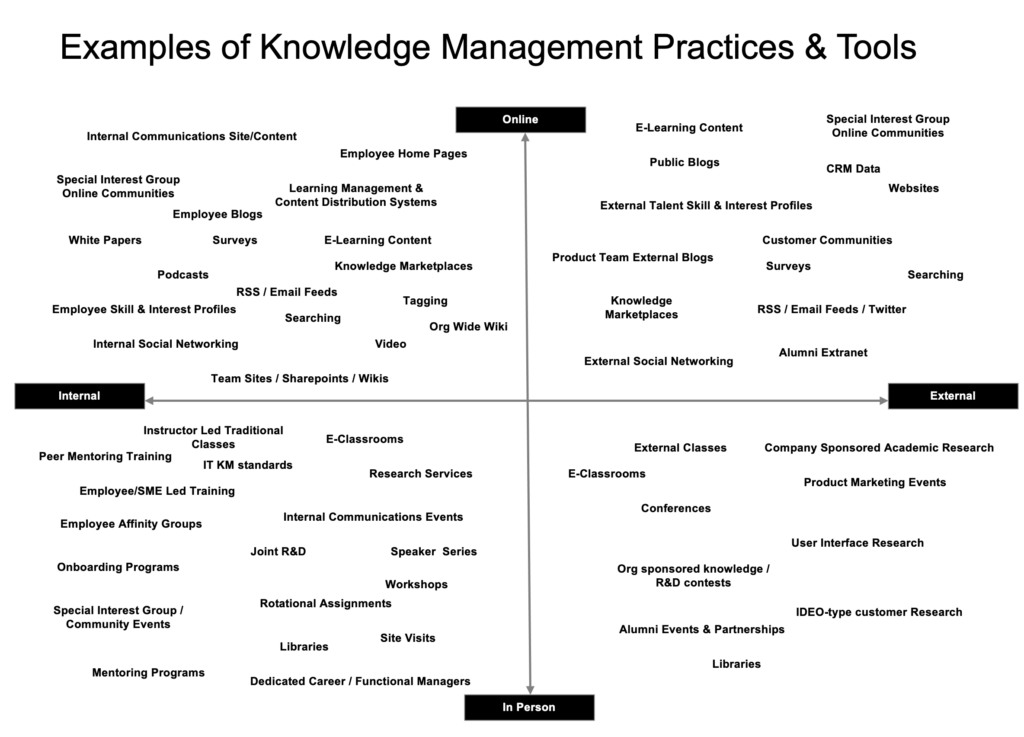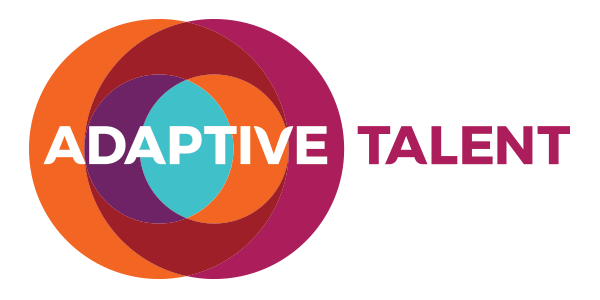(This post was originally written in 2009 during the “great” recession but many of the concepts remain true, albeit now turbocharged with machine learning, big data and data scientists, consumer friendly network analysis, chat services like Microsoft Teams and Slack where people can post questions and links to get help from coworkers on demand, etc.)
As businesses hunker down and move into survival mode, the typical reaction is to eliminate staff and cut spending. While this will cut absolute costs, it really doesn’t begin to touch the most important factor: employee productivity & morale. Lots of employers “gain productivity” by giving employees two jobs but paying them for one, thus killing morale. I think the better focus is improving knowledge management (KM), or how an organization systematically creates, applies, and shares information within and across its boundaries as a source of enhanced productivity and competitive advantage.
In a knowledge economy, ideas create and sustain value so it’s essential for organizations to execute on better ideas faster than the competition. You don’t have to look far for real life examples: consulting (McKinsey) and design companies (IDEO) typically have very strong KM practices because the firm’s value comes from unique combinations of deep & varied specialists applying their knowledge for client benefit.
Companies with robust KM practices have higher productivity per employee, better and faster innovation, and stronger relationships with customers and partners. The key is that leaders try and make their employees more efficient by making the process of knowledge creation, application, and sharing efficient and an essential aspect of the culture. KM is a concept (i.e., efficient creation, sharing, and application of knowledge) that gets enacted through processes, tools, and programs like integrated design teams, new hire orientation, learning & development, subject matter led instruction, waste reduction efforts, customer communities and partnerships, etc.
Generally, in order to share knowledge with someone you need (1) awareness of others’ knowledge (2) belief that that knowledge is high quality and useful (3) trust that the individual will do you no harm. The same things must be true, albeit at a much larger scale, in order for knowledge sharing to occur at an organization wide level.
Internally, leaders must encourage teaching and sharing, essentially moving the knowledge from inside the “heads” of their specialists (called tacit knowledge) to something more accessible, or explicit (like blogs, videos, expertise locators, case studies, classes, webinars, etc.). The more discoverable the information, and the more the organization has fostered relationships across groups, and championed this as important, the more likely it is that individuals will (a) have a rich professional development plan with identified skills to acquire and/or share (b) permission and access to actually acquire, share, and apply that knowledge and (c) awareness of others’ expertise and opportunities to build relationships. By the way, younger employees absolutely expect instant access to a variety of knowledge sources so be prepared for that generational curve ball.
Externally, KM allows organizations to build deeper relationships with their customers. Technology breaks down barriers of all types (distance, legal boundaries, supply chains, etc.) but it’s the organization’s culture that uses these tools to deeply understand the customer, build trust, and create services or products that meet customer needs (or create the next “must-have” product).
I think it’s easiest to think of KM in a 2×2 grid that contrasts internal versus external activities and those which are purely online versus those which are done in person. Here’s a visual to give you a sense of the types of activities that can fall under the broad header of KM:
KM’s form should follow its function, namely advancing your strategies and helping you achieve objectives. Here are some areas:
– Profitability: What strategies exist to boost your profitability? What of those require specific skills or experiences to successfully implement? Are your people aware of others’ tools or technology that might be easily adopted for their projects?
– Innovation: What do your customers need and want and how do your employees acquire those insights? How do your employees stay on top of bleeding edge research and competitor offerings?
– Staff flexibility: Do you have an employee who is the guru in an area but cannot seem to “find the time” to document, teach, or share that knowledge? Would your business benefit from employees being able to sell, support, or develop multiple areas? Do new hires have a positive onboarding experience? Do they slow down their peers as they come up to speed?
– Collaboration: As companies grow larger than 50 people, it becomes impossible for people to be aware of others’ work, competencies, and to have the kind of relationships that allow knowledge sharing and collaboration. Organizational network analysis (ONA) is a KM tool can assess the current state of relationships and knowledge flow between individuals and groups so that positive investments can be made to further organizational performance. In other words, org charts are one view into an organization (hierarchy) but say nothing about how people truly collaborate within the company.
Employers are already spending money on staff – the question is really an issue of return on investment. They often view it as a pure trade-off, a choice between the traditional choices of tangible investments and budgets, or something more complex, difficult to implement, and non-linear like culture and knowledge.
I was recently reading Michael Porter’s writings on innovation and sustainable manufacturing practices, and he saw parallels between the old trade-offs of cost, quality and innovation with today’s concerns about the costs of environmentally sustainable business practices. In the 80s, before total quality management allowed organizations to design quality into the manufacturing process, leaders felt quality could only be improved by adding more inspections, thus driving up costs. It never occurred to them that higher manufacturing quality could come from better design processes. Their filters and old ways of working prevented them from asking the right questions and innovating until someone else did it and then they had to play catch-up. Environmental sustainability is simply another innovation opportunity and you’re already seeing pioneers reframing the issues and offering new ways to delight customers at lower costs in a sustainable way.
So instead of just surviving the recession, spend some time examining your organizational mission and strategies for creating sustained competitive advantage. If they’re largely about execution without a strong focus on sustained innovation across all aspects of your business, I urge you to step back and consider how that will give you a sustained competitive advantage. Anyone can copy your ideas, steal your employees, or meet your prices but your culture can’t be copied and those that nurture innovation are the ones that will attract and retain the best talent and win in today’s world, even if you’re in a capital intensive enterprise.
This has been a lot of information, but please realize any organization can create a culture of innovation with the right people, commitment, and assistance.
I hope this has been helpful and of course the Adaptive Talent team would welcome the opportunity to help you and your team improve your results and adaptability via our culture and organizational development consulting, communications and coaching / mentoring training, total rewards consulting, assessments, leadership coaching and development programs and retained search to help you land high impact talent.

